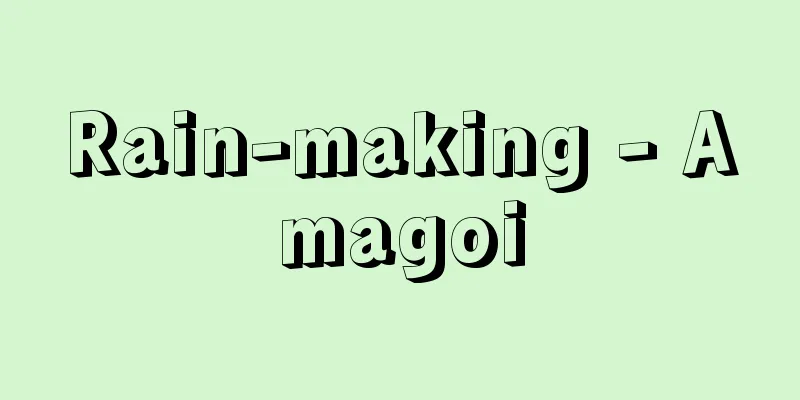Rain-making - Amagoi

|
A religious ritual or incantation to make rain fall. Rain-making rituals are seen all over the world among hunter-gatherers, pastoralists, and agriculturalists, but of course they are rare in areas with heavy rainfall and are particularly prevalent in tropical dry regions, where sun-making rituals are held instead. Rain-making is an important religious ritual, so there are experts called rainmakers, and rain-making rituals are often performed by kings, chiefs, and elders. Among the indigenous people of central Australia, there are tribes such as the Aranda who have groups that regard water as their totem. There are various methods for making rain, but they can be broadly divided into passive methods in which people simply petition the god in charge of water (rain), and active methods in which people try to control the rainfall. When praying to a god, for example in Africa, people sacrifice animals such as cows and goats. In the village of Chamula, a Mayan-speaking Indian in Mexico, each village holds a rain-making ritual every year on May 3rd. In front of a cross in a church, lake, cave, etc., a medicine man (a religious functionary who heals illnesses but also acts as a rainmaker) offers candles and incense and prays to the god. The cross acts as a mediator between the gods and people, and the smoke from the candles and incense rises to the heavens and conveys the words of prayer to the gods. To them, the God of heaven is the sun, Christ, and is also identified with the patron saint of the village, but they believe that the one who directly controls water is the angel (angel) who lives in caves or near waterside areas and is subordinate to God. The Aztecs of ancient Mexico performed human sacrifices to pray to the gods for rain. Corn was sown in the fifth month, but rain-making ceremonies were held in the four months preceding that (each month had 20 days). Many infants with two whorls on their heads were gathered, killed on mountain tops or in lakes, and their hearts were removed. If the child cried when brought to the sacrifice, it was welcomed as it was an omen of rain. Children with two whorls were chosen because they were reminiscent of whirlpools or tornadoes, making them the most suitable offerings to the rain god. The subjects of the sacrifices were the gods Tlaloc, the rain goddess, his sister Chalchiuhtlicue, and the wind god Quetzalcoatl, who guided the rain clouds. In ancient Greece and Rome, people also prayed to Zeus and Jupiter, who were in charge of rain. In addition to simply praying, people often performed rain-making dances to make requests to the gods. One of the important purposes of the sun dances performed by the Plains Indians of North America is to make requests for rain, and participants would dance without drinking water for several days to make requests for rain. There are many ways that humans try to control rain. One way is to force rain by desecrating or harassing gods or sacred things. In Mexico, peasants take statues of saints from churches outside, strip them of their clothes, and leave them in the fields exposed to the scorching sun to force rain. In Thailand, they do the same with statues of Buddha. The opposite method of bathing statues of gods in water is also seen among the Shan people of Myanmar (Burma) and in Europe. The method called mimetic magic in Fraser's classification is also widely used. Actual rain is invited by sprinkling water to imitate rain, lighting fires and making smoke to represent rain clouds, and making sounds reminiscent of thunder. In the Kaitish society, an indigenous people in central Australia, the chief goes to a designated place for rainmaking, has two old men paint red soil to represent a stone with a rainbow, paints a rainbow on his body and shield, and also draws white zigzag lines on his shield to represent lightning. He then sprinkles water on himself and the old men while singing. After returning home, he occasionally throws bird feathers, which represent clouds, into a container of water. The chief's wife imitates the bird cries that evoke rain. The sprinkling of water is particularly widespread, and the burning of fire is used, for example, in Korea, where fires are lit on mountaintops. In Africa, a rainmaking method in which the leaves of a plant associated with rain are burned is also commonly used. Making loud noises is also common in China, where drums are struck and firecrackers are set off. The use of a bullroarer to make strange noises is practiced in Australia, Africa, and Central America. In the Zuni community of the southwestern United States, a rainmaker spins a bullroarer while an assistant mixes water and powder to create bubbles (symbolizing clouds). Other objects believed to have the power to summon rain are used. Frogs are particularly used in various places; for example, in India, frogs are poured with water. Stones are also said to have the magical power to summon rain. In Samoa, a stone representing a rain god is taken to a river and immersed in water to pray for rain, and conversely, in the event of heavy rain, a stone is placed near a fire. Something similar was once done in France using statues of saints. The Azande people of southern Sudan use magic potions to summon rain. [Itabashi Masami] Japanese RainmakingJapanese rain-making practices vary widely, but there are roughly five types: (1) lighting a fire on a mountaintop, (2) dancing to appease the gods and pray for rain, (3) violating taboos against sacred places such as shrines, statues of gods (Buddhas), and waterfalls to anger the gods (Buddhas) and force rain, (4) retreating to a shrine to pray for rain, and (5) bringing holy water from sacred places such as shrines and waterfalls to sprinkle on farmland. In type (1), a fire is lit on the mountaintop, gongs and drums are beaten, and much noise is made. For example, in the suburbs of Takayama City, Gifu Prefecture, rainmaking was previously customarily performed on a mountain called Watayama. A rainmaking hut is also built on the mountaintop, and a stone is enshrined as a deity in one corner of the hut. In front of the hut, a large fire is lit, flutes are played, and drums are beaten, and people usually stay overnight until the rain comes. This type of rainmaking is seen in Iwate, Nagano, Gifu, Aichi, Nara, Osaka, Wakayama, Kyoto, Tottori, Kochi, and Nagasaki prefectures, and is the most widespread of the five types. Climbing the mountain and carrying firewood up the mountain is a considerable amount of work, so there are also some cases where the location seems to have been moved to the edge of a pond, in front of a shrine, or within the grounds of a shrine. Rainmaking ceremonies similar to this method are also seen in various areas of South Korea, mainly in North Jeolla Province and South Gyeongsang Province. The (2) type is a type that appeases the will of the gods with songs and dances and begs the gods for rain. It is not as widespread as the (1) type, but is concentrated in areas mainly in the Kinki region, such as Fukui, Gifu, Mie, Shiga, Nara, and Wakayama, and is also sporadically distributed in Shimane and Ehime prefectures. One example of this rain-making is from Yahata Village, Arida County, Wakayama Prefecture (now Aridagawa Town), where people danced in the precincts of a shrine, chanting, "Even though it's getting so droughty, we started the rain-making dance on the white sand in front of the shrine, and everyone stopped by to dance, but we still can't see the power of the gods." These dances were often performed in a parade through the village in ranks. In the case of (3), the desecration of something that is usually considered sacred is used to anger the gods and force rain. For example, in the area of the source of the Yumesaki River in Himeji City, Hyogo Prefecture, this place is called Kamega-fuchi, and it has been believed since ancient times that if this pool is polluted, rain will surely come. As a result, speculators and investors, who are as sensitive to abnormal weather as farmers, used to throw the innards of horses and cattle into the pool and wait for the weather to get bad. It is said that villagers even posted guards in the village on dry days to prevent the pool from being polluted intentionally. There are various ways to break the taboo, such as tying up Jizo with a rope and dunking it in the river and hitting or beating it, or committing mischief on the shrine. Rainmaking of the type (3) is seen in Aomori, Akita, Fukushima, Nagano, Gifu, Wakayama, and Hyogo prefectures. Rainmaking, which involves resorting to blasphemy or violence to force rain from supernatural beings, is practiced all over the world. For example, in Thailand, statues of Buddha are placed in the open air and exposed to the burning sun in order to make the Buddha aware of its hardships during drought. In France, statues of saints are immersed in water, and the Shan people of mainland Southeast Asia are said to immerse Buddha statues in water when their rice plants are withering due to drought. In the (4) form, one does not climb a mountain or light a fire, but stays in a shrine and prays to the gods all night. "Sanro" is not only practiced for rainmaking but is a common form of prayer in general, but in the case of rainmaking, the way of praying is extremely proactive. For example, in Katsumata, Haibara-cho, Shizuoka Prefecture (now Makinohara City), a form of "standing and waiting" was practiced. In this form, parishioners stayed in the Nishiyama Shrine, the shrine's guardian deity, and stood one by one before the deity, refusing to sleep a wink day and night, while striking the bell to request rain. In many cases, not only villagers but also professionals such as mountain ascetics and priests were involved in the preparations for this type of rainmaking or in the act of staying in a shrine. (5) is the walking water sprinkling type. This type involves getting sacred water from a place that is known to have miraculous powers and sprinkling it. For example, in Gunma and Saitama prefectures, there are places where people go to the Raijin Shrine in Mito to receive sacred water, and if they stop walking on the way back, it starts raining, so they return to their villages without stopping. This type of rainmaking is clearly a kind of imitation magic, as it is believed that sprinkling water will cause a similar phenomenon (rainfall). These are seen in Fukushima, Gunma, Saitama, Nagano, Gifu, Nara prefectures, and Tokyo. This type of rainmaking is also practiced all over the world, and is seen in Russia, North America, northern Australia, Halmahera Island in Indonesia, and New Britain. In addition to the five types of rain-making rituals mentioned above, there are some very bizarre and unusual rain-making rituals seen locally. For example, women wrestling (Akita Prefecture), funerals from the mountains (Akita Prefecture), a man dressed as a frog climbing down a rope stretched from the top of a pillar (Chiba Prefecture), and an inkstone being taken out from each household and washed in the river (Yamaguchi Prefecture). In addition to these kinds of unusual rituals, there are also many that are considered to be variations or combinations of the above five types, and these five rain-making rituals are considered to represent Japanese rain-making rituals. [Koichi Sugiyama] "Takata Shigeo, 'A Study of Rainmaking Customs' (1982, Hosei University Press)" ▽ "Im Jang-hyuk, 'Rain-making Festivals - A Comparative Folkloric Study of Rainmaking Rites in Korea and Japan' (2001, Iwata Shoin)" ▽ "Yabu Motoaki, 'The Establishment and Development of Rainmaking Rites' (2002, Iwata Shoin)" [References] | | | | |Source: Shogakukan Encyclopedia Nipponica About Encyclopedia Nipponica Information | Legend |
|
雨を降らすための呪術(じゅじゅつ)宗教的な儀礼。雨乞いの儀礼は狩猟民、牧畜民、農耕民を問わず世界各地でみられるが、もちろん多雨地帯ではまれで、熱帯乾燥地域でとくに盛んであり、多雨地域では逆に日乞いの儀礼が行われる。雨乞いは宗教儀礼のなかでも重要なものであるため、雨乞い師とよばれる専門家がいたり、しばしば王、首長、長老などが雨乞い儀礼を行う。オーストラリア中部の先住民には、たとえばアランダのように水をトーテムとする集団をもつ部族がある。 雨乞いの方法はさまざまであるが、水(雨)をつかさどる神にひたすら請願する受動的な方法と、人間が降雨をコントロールしようとする能動的な方法とに大別できる。神に祈願する場合は、たとえばアフリカではウシ、ヤギなどの動物供犠(くぎ)を伴う。メキシコのマヤ語系インディオのチャムラ村では毎年5月3日に各集落ごとに雨乞いの儀礼を行う。教会、湖、洞穴などにある十字架の前で呪医(じゅい)(病気治療を行う宗教的職能者であるが雨乞い師でもある)が、ろうそく、香(こう)を捧(ささ)げて神に祈る。十字架は神と人間を媒介するものであり、ろうそくと香の煙は天に上って祈りのことばを神に伝えてくれる。彼らにとって天の神とは、太陽であると同時にキリストでもあり、また村の守護聖人とも同一視されるが、直接水を支配しているのは、神に従属している洞穴や水辺に住む天使(アンヘル)であると考えている。 古代メキシコのアステカでは人身供犠を行って神に雨を祈った。第五の月にトウモロコシの種まきをするが、その前の4か月(1か月は20日)に雨乞い儀礼が行われた。頭につむじが二つある幼児が多数集められ、山の頂上や湖で殺し、心臓を取り出した。いけにえに連れていくとき子供が泣くと雨が多いことの前兆だとして喜ばれた。つむじが二つある子供が選ばれるのは、つむじが渦や竜巻を連想させ、雨の神に捧げるものとしてもっとも適していたからである。いけにえを捧げる対象は雨の神であるトラロックの神々、その姉である雨の女神チャルチウトリクエ、雨雲を先導する風の神ケツァルコアトルであった。 古代ギリシアやローマでも雨をつかさどるゼウスやジュピターに祈った。また単に祈るだけでなく、雨乞い踊りを踊って神に願う場合も多い。北アメリカの平原インディアンが行う太陽踊りの重要な目的の一つは雨乞いであり、参加者は数日間水を飲まず踊ることによって雨を祈るのである。 人間が雨をコントロールしようとする方法はいくつもある。その一つは、神や神聖視されているものを冒涜(ぼうとく)したり困らせて雨を強要する方法である。メキシコの農民の間では教会の聖人像を外に持ち出し、衣服を脱がせ、畑に放置して照りつける太陽にさらして雨を強制することがある。タイでは仏像を同じようにする。逆に神像を水づけにする方法もミャンマー(ビルマ)のシャン人やヨーロッパなどでみられる。 フレーザーの分類で類感(模倣)呪術とよばれる方法も広く行われる。水を振りまいて雨をまねたり、火をたき煙をたてて雨雲を表し、雷を連想させる音をたてるなどして実際の雨を誘う。オーストラリア中部の先住民カイティッシュの社会では首長が雨乞いを行う決まった場所に行き、2人の老人に赤土を塗って虹(にじ)が出る石を表させ、自分の体や盾に虹を描き、盾にはさらに稲妻を表す白いジグザグの線をかく。そして歌いながら自分と老人たちに水を振りかける。家へ戻ってからは、ときどき、水を入れた容器に雲を象徴する鳥の綿毛を投げ入れる。首長の妻は雨を連想させる鳥の鳴き声をまねる。水を振りまく方法はとくに広く行われ、また火を燃やす方法はたとえば朝鮮にあり、山頂で火をたく。アフリカでも雨と結び付く植物の葉を焼く雨乞い方法がよく行われる。大きな音をたてることは中国でもよくみられ、ドラを鳴らし爆竹を放つ。ブルロアラー(うなり板)を使って異様な音を出すことがオーストラリア、アフリカ、中央アメリカなどで行われる。アメリカ合衆国南西部の先住民ズニの社会では手伝いの者が水と粉を混ぜて泡(雲を象徴する)立てている間、雨乞い師がブルロアラーをぐるぐる回し続ける。 そのほか、雨を呼び寄せる力をもつと信じられているものを使う。カエルはとくに各地で用いられ、たとえばインドではカエルに水をかける。石もまた雨を招く呪力をもつとされる。サモアでは雨を降らせる神を表す石を川に持って行って水に浸して雨を祈り、逆に大雨のときには火のそばに置く。似たことがかつてフランスで聖人像を使って行われた。南スーダンのアザンデ人は雨を呼ぶ呪薬を使う。 [板橋作美] 日本の雨乞い日本の雨乞いはさまざまの変異があるが、その方法にはほぼ5種類の類型がある。それは、(1)山頂で火をたく型、(2)踊りで神意を慰め雨を乞う型、(3)神社、神(仏)像、滝つぼなど、神聖なものに対する禁忌を犯し、神(仏)を怒らせて降雨を強請する型、(4)神社に参籠(さんろう)し降雨を祈願する型、(5)神社や滝つぼなどの聖地から霊験ある神水をもらってきて耕地にまく型、である。 (1)の型は、山頂で火を燃やしながら、鉦(かね)や太鼓(たいこ)をたたき大騒ぎをするのである。たとえば岐阜県高山市の近郊では、雨乞いは以前、綿山(わたやま)という山で行うのが慣例であった。山頂には雨乞い小屋も建っており、その一隅に石が神体として祀(まつ)ってある。その前で盛大に火をたき、笛を吹き、太鼓をたたきながら、雨の降るまで泊り込むのを常とした。この型の雨乞いは、岩手、長野、岐阜、愛知、奈良、大阪、和歌山、京都、鳥取、高知、長崎の諸府県にみられ、五つの類型中ではもっとも広い分布を示している。山頂へ登ったり、薪(まき)を運び上げたりするのは相当の労働で、そのため場所を池の端、祠(ほこら)の前、あるいは神社の境内などに移したと思われる例も散見する。この方法に類する雨乞いは韓国(大韓民国)の全羅北道や慶尚南道を中心とした諸地域でもみられる。 (2)の型は、唄(うた)や踊りで神意を慰め神に降雨を懇請する型である。(1)の型ほど広い分布はもたず、福井、岐阜、三重、滋賀、奈良、和歌山などの近畿を中心とする地域に固まり、さらにまた島根、愛媛県に散発的に分布している。この雨乞いの一つの例をあげると、和歌山県の有田(ありだ)郡八幡(やはた)村(現有田川町)という所では、神社の境内で「これほどの ひでりゆくのに 雨乞い踊りを始めて氏神前の白洲(しらす)にて 皆立ち寄りて踊れども 神の威徳はまだ見えぬ」とはやしながら踊ったという。こうした踊りは隊伍(たいご)を整えて村中を練り歩くことが多かった。 (3)の型は、普段は神聖視されているものを冒涜(ぼうとく)して神を怒らせ、強制的に雨を降らせようとするものである。たとえば兵庫県姫路市の夢前(ゆめさき)川の水源地方の例をみると、ここを亀ヶ淵(かめがふち)といい、昔からこの淵を汚すときはかならず降雨があると信じられていた。そこで、天候の異常に農民同様に敏感であった相場師や投資業者が、牛馬の内臓をここに投げ込んで天候の荒れるのを待ったことがあった。村民はこの淵が故意に汚されるのを防ぐために、干天の日などは村で見張りをたてたほどであったという。禁忌を破るやり方はさまざまで、地蔵を縄で縛り上げて川につけ、打ったり、たたいたりする例もあるし、神社にいたずらしたりする。(3)の型の雨乞いは、青森、秋田、福島、長野、岐阜、和歌山、兵庫の各県でみられる。冒涜とか暴力に訴えて超自然物に降雨を強制する雨乞いは世界の各地で行われている。たとえば、タイでは干天時に仏に不自由を思い知らすために、仏像を野天に置いて、燃える太陽にさらす。フランスでは聖者の像を水に浸し、また東南アジア大陸部のシャン人でも干魃(かんばつ)で稲が枯れかかると仏像を水づけにしたという。 (4)の型は、山へも登らず火もたかずに、神社に参籠して夜を徹して神に祈願する型である。「参籠」というのは、雨乞いだけに限らず祈願一般に広く行われるが、雨乞いの場合には、祈請の仕方にきわめて積極的な面がある。たとえば、静岡県榛原(はいばら)町勝間田(かつまた)(現牧之原市)では「立ち待ち」ということが行われた。それは、氏子が氏神の西山神社に詰め、1人ずつ神前に立って昼夜一睡もせず、降雨を強請する一方、釣鐘を打ち鳴らしたのである。この型の雨乞いの準備または参籠そのものには、単に村人だけでなく山伏(やまぶし)とか法印(ほういん)のような専門職の者が関与した例が多い。 (5)の型は、水をまいて歩く型である。この型には、とくに霊験あると評判のある場所の霊水をもらってきてまくのがある。たとえば群馬県や埼玉県では、水戸の雷神(らいじん)様まで御神水を受けに行き、帰る足を休めるとそこで雨が降ってしまうので休まず帰村した所があるという。この型の雨乞いは、水を振りまけばそれと似た現象(降雨)がおこると信じたわけで、明らかに類感呪術的である。これらは福島、群馬、埼玉、長野、岐阜、奈良県や東京都などで認められる。この型の雨乞いも世界各地で行われており、ロシア、北アメリカ、北オーストラリア、インドネシアのハルマヘラ島、ニュー・ブリテン島などにみられる。 以上五つの類型の雨乞いのほか、非常に奇想天外な雨乞いが局地的にみられる。たとえば、女が相撲をとったり(秋田県)、からの葬式を出したり(秋田県)、柱の先端から張り渡した綱をカエルに扮(ふん)した男が伝わって降りたり(千葉県)、各戸1丁ずつ硯(すずり)を出して川で洗ったり(山口県)というぐあいで、さまざまである。この種の奇抜なもののほか、前記五つの類型が変形したり、結合したとみられるものもかなり多く、この五つの雨乞いが日本の雨乞いを代表するものとみられる。 [杉山晃一] 『高谷重夫著『雨乞習俗の研究』(1982・法政大学出版局)』▽『任章赫著『祈雨祭――雨乞い儀礼の韓日比較民俗学的研究』(2001・岩田書院)』▽『籔元晶著『雨乞儀礼の成立と展開』(2002・岩田書院)』 [参照項目] | | | | |出典 小学館 日本大百科全書(ニッポニカ)日本大百科全書(ニッポニカ)について 情報 | 凡例 |
<<: Rain-making dance - Amagoiodori
Recommend
Plant science
...the branch of natural science that studies pla...
Kumejima
One of the Okinawa Islands, this island is locate...
Agha Jali - Agha Jali
...At the foot of the Zagros Mountains, there is ...
Echizenbori
The name of a place in Chuo Ward, Tokyo. Facing th...
Kameizumi Collected Works - Kisen Shusho
Year of death: September 27, 1493 (November 6, 149...
Maurice Herzog
French politician and mountaineer. Born in Lyon. ...
Wake King - Wakeou
Year of death: Tenpyo Jingo 1 (765) Year of birth:...
Mass spectrometry - mass spectrometry
A method for measuring the mass of atoms and molec...
Uesugi Ujinori
Year of death: January 10, 1417 (January 27, 1417)...
Makizono [town] - Makizono
A former town in Aira County in the northeastern p...
Law of Conservation of Momentum
One of the fundamental laws of mechanics. "If...
Harusada Hitotsubashi - Harusada Hitotsubashi
1751-1827 Two generations of the Hitotsubashi fam...
Transient phenomenon - Katogensho
The phenomenon that occurs from when there is a ch...
Weston cell
A type of standard battery. Also known as a cadmiu...
Aadi Kabi - Aadi Kabi
...Therefore, it is impossible to consider this w...









